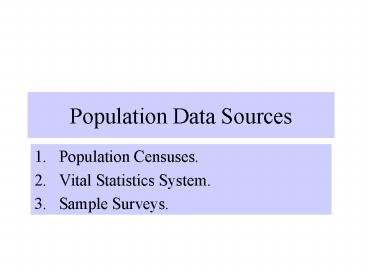Population Data Sources - PowerPoint PPT Presentation
1 / 13
Title:
Population Data Sources
Description:
Population Censuses. Vital Statistics System. Sample Surveys. ... 2- Vital Statistics System. Registration of live births and deaths was made compulsory in 1839. ... – PowerPoint PPT presentation
Number of Views:1147
Avg rating:3.0/5.0
Title: Population Data Sources
1
Population Data Sources
- Population Censuses.
- Vital Statistics System.
- Sample Surveys.
2
1-Population Censuses
- The history of population census in Egypt (in its
modern sense) dates back to the year 1882. The
population count was then 6.7 million. - The following census was carried out in 1897.
Since then a series of six decennial censuses was
implemented in the years ended in 7 until the
census of 1947, the following census was
undertaken in 1960. - In 1966, another census was carried out on a
sample basis, it has been followed by three
decennial censuses in the years 1976, 1986, 1996. - For the time being, the preparatory activities
for the 2006 census are underway. - On the basis of the 1996 census and natural
increase method, the population of Egypt is
estimated on the 1st of July 2004 as of 69.3
Million.
3
(a) Enumeration Basis
- Enumeration is implemented on a Defacto basis,
with slight modification so as to include all
nationals temporarily existing abroad in the
census time.
4
(b) Census Contents
- Demographic Data Items relationship to head of
HH, sex, age, place of usual residence, place of
birth, place of previous residence, duration of
stay in current residence. - Social Data Items Marital status, Educational
attainment, School enrolment, Disability. - Economic Data Items Participation in Economic
activity, Employment status, Occupation(ISCO),Indu
stry(ISIC), Economic sector - Housing Data Items housing type and tenure, No.
of rooms, utilities, sanitary conditions,
availability of appliances and equipment.
5
(C) Geographic division
- The country is divided into 26 governorates as
follows - Urban governorates 4
- Lower Egypt Governorates 9
- Upper Egypt Governorates 8
- Frontier Governorates 5
- Apart from Urban governorates all others have
rural and urban components
6
2- Vital Statistics System
- Registration of live births and deaths was made
compulsory in 1839. - In 1912 the system was extended to cover still
births. - Marriage and divorce was included in the system
in 1921. - Registration grace period is 24 hours for death
and one week for birth events.
7
(a) Administration of VS System
- Three governmental organizations participate in
the VS System Ministry of Health and Population,
Ministry of Interior, and Central Agency for
Public Mobilization and Statistics (CAPMAS). - CAPMAS is responsible for preparing and
publishing annually data of birth , death and
marriage/divorce events.
8
(b) Contents of vital records
- Birth event Place of birth, Date of birth, place
of usual residence of mother, Type of birth,
Birth order, Sex, Age of parents, Occupation of
parents. - Death event Place of occurrence, Date of
occurrence, Place of usual residence, Age, Sex,
Occupation, Cause of death
9
( c ) Completeness of Registration
- Birth Analytic studies have shown that the
completeness of birth registration in Egypt is
more than 90 with higher level in urban areas. - Death It has also been judged upon that death
registration is slightly below 90. The
relatively higher level of death
under-registration results from failure of
registering a fairly good portion of infant
deaths babies die immediately after birth,
particularly in rural areas, escape registration
either as birth or death events.
10
3- Sample Surveys
- Two nationwide households surveys are conducted
regularly, namely - 1- Demographic and Health Survey
- Program (DHS)
- 2- Labor force Survey.
11
(a) Demographic and Health Survey
- Conducted almost every five years on a sample of
about 15000 households. - It is the main source of KAP information
pertinent to RH/FP issues. - Provide better estimates of infant and below five
mortality rates. - Provide estimates at the level of the whole
nation as well as the five major geographic
divisions Urban governorates Urban Lower Egypt
Rural Lower Egypt Urban Upper Egypt and Rural
Upper Egypt.
12
(B) Labor Force Survey
- Conducted annually in four rounds (quarterly) on
a sample of 20000 household each round. - It is the main source of labor force structures
and distributions, and unemployment level and
differential. - Provide annual estimates at the level of the
whole nation, major geographic subdivisions and
governorate (pooled data). - Provide summary quarterly estimates at the level
of the total nation and major geographic
subdivisions. - The survey is not conducted in census years.
13
Thank you































